When it comes to losing weight and achieving a toned body, the idea of turning to foods that burn fat sounds enticing.
But is there really such a thing as “fat-burning” foods? In this article, we will uncover the truth behind the concept and explore whether certain foods can truly accelerate fat loss.
Understanding the Science of Fat Loss
Before delving into the specifics of fat-burning foods, it is crucial to understand the science behind fat loss. When our bodies require energy, they primarily rely on stored fat as a fuel source.
This process occurs through a metabolic pathway called lipolysis, where fat cells release stored triglycerides to be broken down into fatty acids and glycerol.
To trigger lipolysis, your body needs to be in a calorie deficit, meaning you consume fewer calories than you burn.
This deficit forces your body to tap into its fat stores to make up for the energy shortfall, resulting in weight loss and a reduction in body fat percentage.
Foods That Boost Metabolism
While no single food can directly burn fat, certain foods can boost metabolism, which can indirectly aid in fat loss. Metabolism refers to the chemical processes that occur within the body to convert food into energy.
Some foods can increase the metabolic rate temporarily, leading to the burning of more calories throughout the day.
1. Green Tea: Rich in catechins and caffeine, green tea has been shown to boost metabolism and enhance fat oxidation. However, its effects are modest, and it should not be viewed as a magic potion for weight loss.
2. Chili Peppers: Capsaicin, the compound responsible for the spicy kick in chili peppers, can increase metabolism and promote the burning of calories. Consuming spicy foods may lead to a temporary rise in metabolism.
3. Coffee: The caffeine in coffee stimulates the central nervous system, increasing metabolism and promoting the breakdown of fat cells.
However, excessive consumption can have adverse effects on health and should be consumed in moderation.
4. Lean Proteins: Foods such as chicken, turkey, fish, and legumes require more energy to digest compared to fats or carbohydrates. This thermogenic effect of protein boosts metabolism and can contribute to increased calorie burning.
The Role of Fiber in Fat Loss
Foods high in fiber can play a crucial role in weight management and fat loss. Although fiber itself does not burn fat, it provides several benefits that support the overall weight loss process.
5. Fruits and Vegetables: Rich in fiber, fruits and vegetables promote a feeling of fullness and reduce hunger cravings, which can aid in creating a calorie deficit and ultimately lead to fat loss.
6. Whole Grains: Unlike refined grains, whole grains are high in fiber, which slows down digestion and helps control blood sugar levels. This steady release of energy can prevent cravings and maintain a stable metabolism.
7. Legumes: Legumes, such as lentils and beans, are not only excellent sources of fiber but also protein. This combination of nutrients is incredibly satiating and can contribute to weight loss by reducing overall calorie intake.
The Myth of Negative-Calorie Foods
Many weight loss enthusiasts often hail certain foods as “negative-calorie” or “calorie-negative” options, claiming that it takes more energy to digest these foods than the calories they provide.
However, this concept is largely misleading and lacks scientific evidence.
While certain low-calorie foods like celery, cucumbers, and leafy greens may have minimal caloric content, the energy expended during digestion is not significantly higher than the calories they provide.
These foods can still be part of a healthy diet but should not be solely relied upon as fat-burning miracles.
The Importance of a Balanced Diet and Exercise
The key to successful fat loss lies in adopting a balanced diet that includes a variety of nutrient-rich foods.
No single food can have a significant impact on fat burning without considering the overall diet’s composition and individual calorie needs.
Furthermore, regular physical activity and exercise cannot be overlooked. Aerobic exercises, strength training, and high-intensity interval training (HIIT) can all contribute to increased calorie burning and overall fat loss.
Conclusion
In conclusion, while the concept of foods that burn fat might be appealing, there are no magical solutions to weight loss.
Certain foods can support the fat loss process by boosting metabolism or promoting feelings of fullness, but they alone cannot miraculously burn fat. To achieve sustainable and healthy fat loss, it is essential to focus on maintaining a calorie deficit through a balanced diet and regular exercise.




























